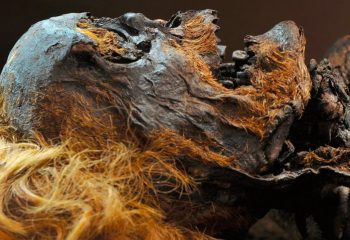
The Astonishingly Preserved “Roter Franz”: A Man with Hair, Beard, and Eye-Catching Red Eyebrows Revealed
Roter Franz is the mummy of a young man found in the Bourtanger swamp, on the border between Holland and Germany, in 1900. Also known as “Neu Versen Man”, the nickname derives from the color of beard, hair and eyebrows, completely red, coloring due to the presence of acids in the peat bog.
The man, who died between 25 and 32 years of age, lived between 220 and 430 AC, when he was killed by a deep cut in the throat, of which the signs remain in the soft mummified tissues. The man was certainly an expert jockey, particular discovered because of the conformation of the bones of the thighs, which reveal how, in life, had developed a substantial musculature of the legs due to long periods spent on horseback.

Roter Franz underwent several traumas before he died, among them a broken and healed clavicle and a deep arrow wound or lance on his arm, also healed. High between 180 and 185 centimeters, one hypothesis is that the man could be a professional rider at the service of the Roman Legions.
There are two hypotheses about the causes of his Death. According to the first, Franz died during a ritual human sacrifice, during which he was beheaded and buried in the swamp. Although this is a plausible theory, the position of the body is absolutely unusual for a sacrificed person, who was usually lying supine on the ground.
According to the second, the knight died robbed, his throat slashed by his assailants. This theory would be circumstantiated by numerous indications, first of all the total absence of clothes on the corpse, the lack of ears eaten by animals, the worst conservation of the lower body and the casual position in which the mummy was located. The corpse would in fact have been naturally buried by the movements of the swampy ground and not, as would have been logical in a human sacrifice, by its killers. This hypothesis has been corroborated by the studies of Professor Hayden of 1957, which found different types of pollen on the tissues of the mummy.

An interesting detail of the discovery of the cause of death, certainly the cut at the throat, is the randomness of its identification: the scientists had laid him supine in his museum, until they turned it, seeing the deep cut in the throat, still visible in the soft tissue between the back and shoulders. Still today Roter Franz rests in the Provincial Museum of Hannover, Germany (photos below)




